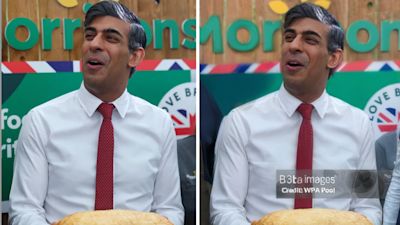General Election 2024: How to spot misinformation and fakes

How do you know what's real and what's not when it lands on your election feed on socials?
A lot has already been made of some of Rishi Sunak's 'slip-ups' on his campaigning around the UK.
A picture of him under an 'exit' sign on his plane from Northern Ireland to Birmingham got widely shared on socials, while a separate clip of the prime minister taking questions at the site of the Titanic also hasn't helped the Tories' campaign so far.
But, a picture of the Sunak appearing to meet Morrisons employees on the campaign trail with the word 'moron' spelled out behind him was actually edited.
It was posted to X and has been claimed by user 'Happy Toast'.
The image was originally taken earlier in the month during a 'Farm to Fork' summit for members of the farming and food industries in Downing Street.
A closer look shows blurring around the edge of Sunak's head, as well as colour smudges - while the watermark doesn't look quite right.
It's not been the only election content on socials that has been re-purposed from well before the election campaigning began.
Thousands have now shared a video posted on X of Labour Party candidate Rachael Maskell, including GB News broadcaster Darren Grimes.
The original video, posted by BBC Radio York back in 2015 was from a refugee rally and was in response to then Prime Minister David Cameron setting a 20,000-person quota for accepting Syrian war refugees.
The claim, made by Grimes and others, has been branded "misleading". ITV News have contacted the Labour Party for a response to the posts.
So how do you know what to trust? Well there are usually some giveaways with the quality of a video or photo.
You can also reverse-image search something to see where it's come from - or search for keywords to help you trace it back.
Meta revealed in February 2024 that it would begin labelling images posted to Facebook, Instagram and Threads that it detected had been created using artificial intelligence.
TikTok also said it would remove any content that flouted its strict rules.
So if you're not sure, then don't share it. You could be adding to the misinformation.
"A lot of it is actually down to us the public, to make sure that we don't always succumb to the temptation to hit forward or hit share," explains Chris Morris, of independent fact checkers Full Fact.
"We've all seen the financial scams through text, audio or video on our phone and I think we can expect to see political equivalents of those in the coming weeks, so we need to be prepared for it and deal with it sensibly."
Audio clips are also seen as some of the hardest pieces of content to verify.
"We asked audio experts, 'what do you think' and they said it's almost impossible to tell whether something has been generated by AI.
"Video is one step behind and there are clues. Ears are often a bit weird, there are sometimes little glitches on people's faces."
And it's not just videos that are circulated, claims from different parties that are not true can also cause problems, as Chris explains.
"It's really important for the media and organisations like Full Fact not to spend so much time chasing the deepfakes, that we forget to actually check the things that people do say.
"I suspect most of the duff information we're going to experience from this campaign is going to come out of the mouths of real people."
This all comes as the Alan Turing Institute warned that action was needed to protect the UK election from AI disinformation, calling on the Electoral Commission and Ofcom to create guidelines and get agreements from political parties on how AI might be used in campaigning.
However, the study did find that there was "limited evidence" that AI would impact election results, but that it could still be used to incite hate and spread disinformation online.
Don't forget to follow @ITVPolitics on TikTok and Instagram to keep across the latest election news
Want a quick and expert briefing on the biggest news stories? Listen to our latest podcasts to find out What You Need To Know...